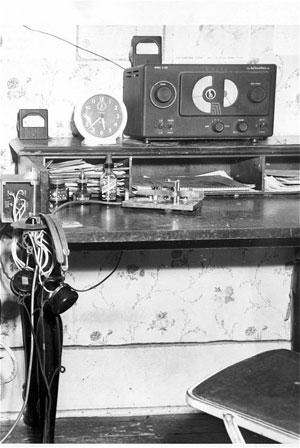Ron Baker, WA6AZN
(formerly WN8JIA (1952), W8JIA, W3ZHJ, W1CQL)
 This is a shot of my ham station in the early 1950's. The receiver is the Hallicrafters model S-38B which was a vacuum tube AC receiver that covered the broadcast band to 30 MHz in several bands. It was a "Bare Bones" receiver, and cost about $50 in 1951-52. You calibrated it by keying a crystal controlled rig and zero beating it on the main tuning dial. Once set, the "Band Spread" dial was a kind of "fine tuning" control. In the Novice days I operated on 3746.5 MHz, my crystal which was purchased. The Novice band on 80 meters back then was 3700 to 3750. I used that receiver for over 3 years, even as a General Class ham. This is a shot of my ham station in the early 1950's. The receiver is the Hallicrafters model S-38B which was a vacuum tube AC receiver that covered the broadcast band to 30 MHz in several bands. It was a "Bare Bones" receiver, and cost about $50 in 1951-52. You calibrated it by keying a crystal controlled rig and zero beating it on the main tuning dial. Once set, the "Band Spread" dial was a kind of "fine tuning" control. In the Novice days I operated on 3746.5 MHz, my crystal which was purchased. The Novice band on 80 meters back then was 3700 to 3750. I used that receiver for over 3 years, even as a General Class ham.
On the table you will see not a "straight key" (I used one but it was away from the desk at that time) but a home made "Side Swiper". A converted "Bug" with a broken hack saw blade and some change in wiring. You made dots and dashes on both sides and it produced a fairly "novel" sounding "fist". You could also use it as a straight key, by using only one side, which I did often. Later on as a General, I converted this back to the standard "Bug" which could send at a higher speed.
On the left side is an Army surplus CW filter. With the headphones, it had a switch for several settings that would "isolate" a signal in case of QRM. Yes, even in Novice days, we would often find ourselves with two hams using crystals on or very near to each other in frequency. We would call CQ and then tune up and down the band to see who was calling. None of that "zero beating" that became popular with VFO's later on. Novice were not allowed to use a VFO however.
Directly under the radio is the log book. The clock was to record times. One of the two meters was a "Field Strength" meter so I knew when the one tube oscillator was working OK or not. The other meter..... well, thats
anyone's guess at this time.
(photo courtesy my Dad, now SK) |